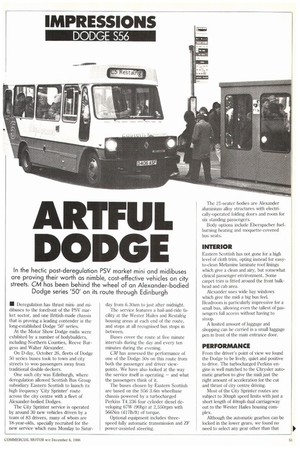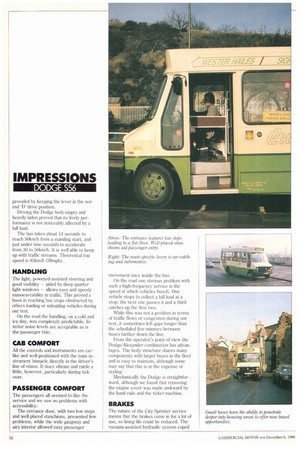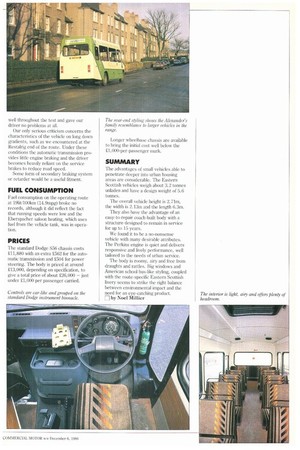ARTFUL DOD
Page 63

Page 64

Page 65

If you've noticed an error in this article please click here to report it so we can fix it.
In the hectic post-deregulation PSV market mini and midibuses are proving their worth as nimble, cost-effective vehicles on city streets. CM has been behind the wheel of an Alexander-bodied Dodge series '50' on its route through Edinburgh
• Deregulation has thrust miniand midibuses to the forefront of the PSV market sector, and one British-made chassis that is proving a leading contender is the long-established Dodge '50' series.
At the Motor Show Dodge midis were exhibited by a number of bodybuilders, including Northern Counties, Reeve Burgess and Walter Alexander.
On D-day, October 26, fleets of Dodge 50 series buses took to town and city streets to woo passengers away from traditional double-deckers.
One such city was Edinburgh, where deregulation allowed Scottish Bus Group subsidiary Eastern Scottish to launch its high frequency 'City Sprinter' route across the city centre with a fleet of Alexander-bodied Dodges.
The City Sprinter service is operated by around 30 new vehicles driven by a team of 83 drivers, many of whom are 18-year-olds, specially recruited for the new service which runs Monday to Satur day from 6.30am to just after midnight.
The service features a hail-and-ride facility at the Wester Hailes and Resta'rig housing areas at each end of the route, and stops at all recognised bus stops in between.
Buses cover the route at five minute intervals during the day and every ten minutes during the evening.
CM has assessed the performance of one of the Dodge 50s on this route from both the passenger and driver viewpoints. We have also looked at the way the service itself is operating — and what the passengers think of it.
The buses chosen by Eastern Scottish are based on the S56 3.6m wheelbase chassis powered by a turbocharged Perkins '1'4.236 four cylinder diesel developing 67W (90hp) at 2,550rpm with 566Nm (4171b/ft) of torque.
Optional equipment includes threespeed fully automatic transmission and ZF power-assisted steering. The 21-seater bodies are Alexander aluminium alloy structures with electrically-operated folding doors and room for six standing passengers.
Body options include Eberspacher fuelburning heating and moquette-covered bus seats.
INTERIOR
Eastern Scottish has not gone for a high level of cloth trim, opting instead for easyto-clean Melamine laminate roof linings which give a clean and airy, but somewhat clinical passenger environment. Some carpet trim is fitted around the front bulkhead and cab area.
Alexander uses wide bay windows which give the midi a big bus feel. Headroom is particularly impressive for a small bus, allowing even the tallest of passengers full access without having to stoop.
A limited amount of luggage and shopping can be carried in a small luggage pen in front of the main entrance door.
PERFORMANCE
From the driver's point of view we found the Dodge to be lively, quiet and positive to drive. The turbocharged Perkins engine is well matched to the Chrysler automatic gearbox to give the midi just the right amount of acceleration for the cut and thrust of city centre driving.
Most of the City Sprinter routes are subject to 30mph speed limits with just a short length of 40mph dual carriageway out to the Wester Hailes housing complex.
Although the automatic gearbox can be locked in the lower gears, we found no need to select any gear other than that provided by keeping the lever in the normal Ts' drive position.
Driving the Dodge both empty and heavily laden proved that its lively performance is not noticeably affected by a full load.
The bus takes about 14 seconds to reach 50kin/h from a standing start, and just under nine seconds to accelerate from 30 to 50km/h. It is well able to keep up with traffic streams. Theoretical top speed is 95kmih (59mph).
HANDLING
The light, powered-assisted steering and good visibility — aided by deep quarter light windows — allows easy and speedy manoeuvrability in traffic. This proved a boon in reaching bus stops obstructed by others loading or unloading vehicles during our test.
On the road the handling, on a cold and icy day, was completely predictable. Interior noise levels are acceptable as is the passenger ride.
CAB COMFORT
All the controls and instruments are carlike and well-positioned with the main instrument binnacle directly in the driver's line of vision. It does vibrate and rattle a little, however, particularly during tickover.
PASSENGER COMFORT
The passengers all seemed to like the service and we saw no problems with accessibility.
The entrance door, with two low steps and well placed stanchions, presented few problems, while the wide gangway and airy interior allowed easy passenger movement once inside the bus.
On the road one obvious problem with such a high-frequency service is the speed at which vehicles bunch. One vehicle stops to collect a full load at a stop; the next one passes it and a third catches up the first two.
While this was not a problem in terms of traffic flows or congestion during our test, it sometimes left gaps longer than the scheduled five minutes between buses further down the line.
From the operator's point of view the Dodge/Alexander combination has advantages. The body structure shares many components with larger buses in the fleet and is easy to maintain, although some may say that this is at the expense of styling.
Mechanically the Dodge is straightforward, although we found that removing the engine cover was made awkward by the hand-rails and the ticket machine.
BRAKES
The nature of the City Sprinter service means that the brakes come in for a lot of use, so lining life could be reduced. The vacuum-assisted hydraulic system coped well throughout the test and gave our driver no problems at all.
Our only serious criticism concerns the characteristics of the vehicle on long down gradients, such as we encountered at the Resta[rig end of the route. Under these conditions the automatic transmission provides little engine braking and the driver becomes heavily reliant on the service brakes to reduce road speed.
Some form of secondary braking system or retarder would be a useful fitment.
FUEL CONSUMPTION
Fuel consumption on the operating route at 19lit/100km (14.9mpg) broke no records, although it did reflect the fact that running speeds were low and the Eberspacher saloon heating, which uses fuel from the vehicle tank, was in operation.
PRICES
The standard Dodge S56 chassis costs £11,880 with an extra £562 for the automatic transmission and £504 for power steering. The body is priced at around £13,000, depending on specification, to give a total price of about £26,000 — just under £1,000 per passenger carried. The rear-end styling shows the Alexander's family resemblance to larger vehicles in the range.
Longer wheelbase chassis are available to bring the initial cost well below the £1,000-per-passenger mark.
SUMMARY
The advantages of small vehicles able to penetrate deeper into urban housing areas are considerable. The Eastern Scottish vehicles weigh about 3.2 tonnes unladen and have a design weight of 5.6 tonnes.
The overall vehicle height is 2.71m, the width is 2.13in and the length 6.3m.
They also have the advantage of an easy-to-repair coach-built body with a structure designed to remain in service for up to 15 years.
We found it to be a no-nonsense vehicle with many desirable attributes. The Perkins engine is quiet and delivers responsive and lively performance, well tailored to the needs of urban service.
The body is roomy, airy and free from draughts and rattles. Rig windows and American school bus-like styling, coupled with the route-specific Eastern Scottish livery seems to strike the right balance between environmental impact and the need for an eye-catching product. Ei by Noel Millier














































































































